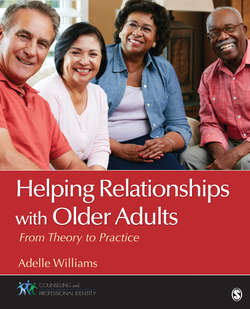Читать книгу Helping Relationships With Older Adults - Adelle M. Williams - Страница 14
На сайте Литреса книга снята с продажи.
Learning Objectives
ОглавлениеAfter reading this chapter, you will be able to
1 Describe the basic changes that occur in the aging process
2 Analyze the various biological theories that explain aging
3 Examine the normative physical changes that accompany the aging process
4 Explain the cognitive changes that accompany aging
The aging of the population is one of the most profound and far-reaching changes affecting contemporary society. Between 2014 and 2060, the U.S. population is projected to increase from 319 million to 417 million, reaching 400 million in 2051 (Colby & Ortman, 2014). By 2030, one in five Americans is projected to be 65 and over (Colby & Ortman, 2014). In 2014, the 65 plus population is expected to grow from 15% gradually upwards to 24% by 2060 (Colby & Ortman, 2014). The baby boomers (individuals born between 1946 and 1964) largely account for the increase in this demographic, as they began turning 65 in 2011. By 2050, the surviving baby boomers will be over the age of 85.
The aging of the population has wide-ranging implications for the country. By aging, demographers often mean that the proportion of the population in the older age range increases. As the United States ages over the next several decades, its older population will become more racially and ethnically diverse. The projected growth of the older U.S. population will present challenges to policymakers and programs. It will also affect families, businesses, and health care providers (Ortman, Velkoff, & Hogan, 2014). There is a clear need for health professionals with a thorough understanding and appreciation for the experiences of this older population. With so many individuals over age 65, mental health professionals with the expertise to assess and treat the problems of later life are sorely needed (Zarit & Zarit, 2011).
People are not just living longer, but they are living better longer than ever before. Improvements in disease prevention and health promotion, the widespread availability of public and private pensions and other financial benefits, and increased educational opportunities for each successive generation have dramatically improved the lives of today’s society. The next generation of older people will have had better education and have taken better care of their health across the life span, so their prospects for successful old age are even greater (Zarit & Zarit, 2011).
These demographic and social changes mean that an increasing number of older people are in need of psychological services. The mental health field, however, has been slow to respond with adequate numbers of trained professionals who have specialized training in geriatrics. For many years, geriatric practice was a backwater, a minor field viewed condescendingly by clinicians who felt that little could be done for anyone over age 50 (Zarit & Zarit, 2011). That viewpoint was a luxury of a society that had relatively few older people. The dramatic expansion of life expectancy and growth in the proportion of people over age 65, coupled with empirical findings of the effectiveness of treatment for many problems of later life, provides a solid foundation for geriatric mental health practice. The number of clinicians with geriatric expertise, however, falls far short of the need (Zarit & Zarit, 2011).
Aging is a natural and inevitable process and a very complex one. Many changes occur in this process; however, no two persons experience these changes at the same time or at the same rate. It is a variable experience. Some elders accept the natural changes that occur as a positive experience, while others view these changes with disgust and frustration. The process of aging is also a time to explore hidden talents, engage in new activities, commit to new relationships, and express oneself in novel and creative ways. Aging is more than the physical, social, psychological, and environmental changes. It involves a renewed energy and appreciation for life, opportunities to explore, and an inner transformation that is unique to every aging individual.
